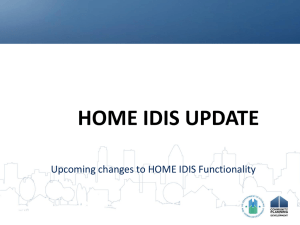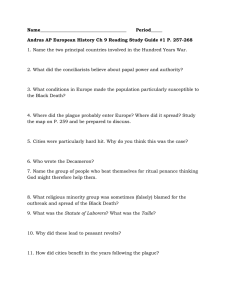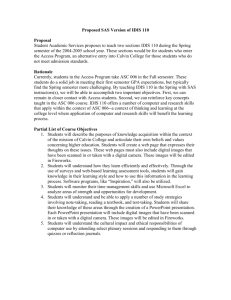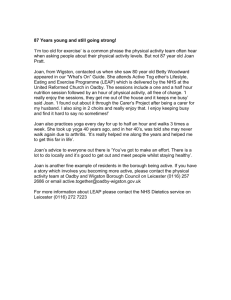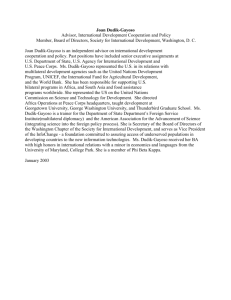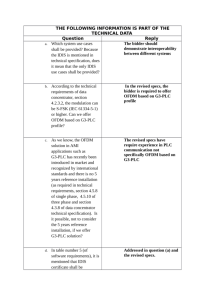(2)
advertisement
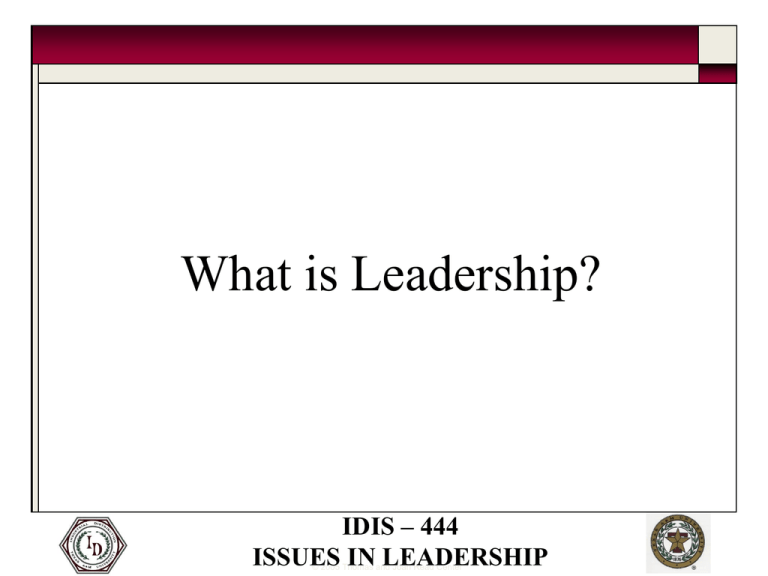
What is Leadership? IDIS – 444 ISSUES IN LEADERSHIP © 2005 Thomas and Joan Read Center A Leadership Story: •A group of workers and their leaders have the task of clearing a road through a dense jungle on a remote island to get to the coast where an estuary provides a perfect site for a port. •The leaders organize the work force into efficient units and monitor the progress which is excellent. The leaders continue to monitor and evaluate the project, making adjustments along the way to ensure the progress is maintained and efficiency is increased wherever possible. •Then, one day during all the hustle and bustle and activity, one person climbs up a nearby tree. That person surveys the scene from the top of the tree. IDIS – 444 ISSUES IN LEADERSHIP © 2005 Thomas and Joan Read Center 2 A Leadership Story: •And shouts down to the assembled group below….. •“Wrong Way!”……. •(Story adapted from Stephen Covey (2004) “The Seven Habits of Highly Effective People” Simon & Schuster). •“Management is doing things right, leadership is doing the right things” (Warren Bennis and Peter Drucker) IDIS – 444 ISSUES IN LEADERSHIP © 2005 Thomas and Joan Read Center 3 THE TRADITIONAL FUNCTIONS OF MANAGEMENT Planning Select goals and ways to obtain them Organizing Controlling Assign authority and responsibility for task accomplishment Monitor activities and Make corrections Directing Staffing Motivate and coordinate employees Recruit and obtain employees IDIS – 444 ISSUES IN LEADERSHIP © 2005 Thomas and Joan Read Center Manager Roles Category Role Activity Informational Monitor Seek and receive information, scan periodicals and reports, maintain personal contacts. Disseminator Forward information to other organization members; send memos and reports; make phone calls. Spokesperson Transmit information to outsiders through speeches, reports, memos. Figurehead Perform ceremonial and symbolic duties such as greeting visitors, signing legal documents. Leader Direct and motivate subordinates; train, counsel, and communicate with subordinates Liaison Maintain information links both inside and outside organization; use mail, phone calls, meetings. Entrepreneur Initiate improvement projects; identify new ideas; delegate idea responsibility to others Disturbance Handler Take corrective action during disputes or crises; resolve conflicts among subordinates; adapt to environmental crises. Resource allocator Decide who gets resources; schedule, budget, set priorities Negotiator Represent department during negotiation of union contracts, sales purchases, budgets; represent departmental interests. Interpersonal Decisional IDIS – 444 ISSUES IN LEADERSHIP © 2005 Thomas and Joan Read Center COMPARING MANAGEMENT AND LEADERSHIP Management Leadership Direction Planning and budgeting Keeping eye on bottom lime Creating vision and strategy Keeping eye on horizon Alignment Organizing and staffing Directing and controlling Create boundaries Creating shared culture and values Helping others grow Reduce boundaries Relationships Focusing on objects – producing/selling goods services Based on position power Acting on boss Focusing on people-inspiring and motivating followers Based on personal power Acting as coach, facilitator, servant Emotional distance Expert mind Talking Conformity Insight into organization Emotional connections (Heart) Open mind (Mindfulness) Listening (Communication) Nonconformity (Courage) Insight into self (integrity) Maintains stability Creates change, often radical change Personal Qualities Outcomes IDIS – 444 ISSUES IN LEADERSHIP © 2005 Thomas and Joan Read Center A Model of Leadership Leadership Theories Types of Leadership Styles Leadership Factors Affecting Style Change Leadership IDIS – 444 ISSUES IN LEADERSHIP © 2005 Thomas and Joan Read Center 7 Leadership Theories Trait Transformational Transactional Leadership Behavioral Contingency IDIS – 444 ISSUES IN LEADERSHIP © 2005 Thomas and Joan Read Center 8 Trait Theories •Is there a set of characteristics that determine a good leader? •Earlier Concepts - Height? - Confidence? - Physical Stamina? IDIS – 444 ISSUES IN LEADERSHIP © 2005 Thomas and Joan Read Center 9 Trait Theories •Present (Leaders Are Different) - Personality? - Dominance and Personal Presence? - Charisma? - Self Confidence? - Achievement? - Knowledge of the Business? - Ability to Formulate a Clear Vision? IDIS – 444 ISSUES IN LEADERSHIP © 2005 Thomas and Joan Read Center 10 •Trait Theories Implications - Are such characteristics inherently gender biased? - Do such characteristics produce good leaders? - Is leadership more than just bringing about change? - Does this imply that leaders are born not bred? IDIS – 444 ISSUES IN LEADERSHIP © 2005 Thomas and Joan Read Center 11 Transformational Leadership •Assumptions - People will follow a person who inspires them; - A person with vision can achieve great things; - The way to get things done is by injecting enthusiasm and energy; •If successful, can bring widespread changes to a business or organization IDIS – 444 ISSUES IN LEADERSHIP © 2005 Thomas and Joan Read Center 12 Implications •Requires - Long term strategic planning - Clear objectives - Clear vision - Leading by example – walk the walk - Efficiency of systems and processes IDIS – 444 ISSUES IN LEADERSHIP © 2005 Thomas and Joan Read Center 13 Transactional Leadership •Based on an exchange between the leader and the follower of reward for applied effort; •Assumptions - People are motivated by reward and punishment; - Social systems work best with a clear chain of command; - The prime purpose of a subordinate is to do what their manager tells them to do •Despite considerable research that highlights its limitations, transactional leadership is very popular with many managers IDIS – 444 ISSUES IN LEADERSHIP © 2005 Thomas and Joan Read Center 14 •Requires Implications -Focus on the management of the organization -Focus on procedures and efficiency -Focus on working to rules and contracts -Managing current issues and problems IDIS – 444 ISSUES IN LEADERSHIP © 2005 Thomas and Joan Read Center 15 •Assumptions Behavioral Theory - Leaders can be made, rather than being born; - Leaders can be trained; - Consider the way of doing things •Behavior theory is easy to develop - Determine success and the actions of leaders - Identify failures and the actions of leaders IDIS – 444 ISSUES IN LEADERSHIP © 2005 Thomas and Joan Read Center 16 Implications •Leader institutes tasks and structures •Process orientated IDIS – 444 ISSUES IN LEADERSHIP © 2005 Thomas and Joan Read Center 17 Contingency Theory •Leader’s ability to lead is contingent upon: - Situational factors - Leader’s style - Capabilities and behaviors of followers •Assumption - Leadership is not a fixed set of characteristics that can be transposed into different contexts IDIS – 444 ISSUES IN LEADERSHIP © 2005 Thomas and Joan Read Center 18 Implications •Success or failure may depend on : - Type of staff - History of the business - Culture of the business - Quality of the relationships - Nature of the changes needed - Accepted norms within the business IDIS – 444 ISSUES IN LEADERSHIP © 2005 Thomas and Joan Read Center 19 Factors Affecting Style •Risk Factors •Type of Business •Necessity for Change •Nature of the Task •Organizational Culture IDIS – 444 ISSUES IN LEADERSHIP © 2005 Thomas and Joan Read Center 20 Types of Leadership Style •Autocratic •Participative •Laissez Faire (Hands off) •Paternalistic IDIS – 444 ISSUES IN LEADERSHIP © 2005 Thomas and Joan Read Center 21 Autocratic •Leader makes decisions without reference to anyone else •High degree of dependency on the leader •Can create de-motivation and alienation of staff •May be valuable in some types of business where decisions need to be made quickly and decisively IDIS – 444 ISSUES IN LEADERSHIP © 2005 Thomas and Joan Read Center 22 Participative •Encourages decision making from different perspectives - leadership may be emphasized throughout the organization - Consultative : process of consultation before decisions are taken - Persuasive : Leader makes decision and seeks to persuade others that the decision is correct IDIS – 444 ISSUES IN LEADERSHIP © 2005 Thomas and Joan Read Center 23 Participative •May help motivation and involvement •Worker feel ownership of the business and its ideas •Improves the sharing of ideas and experiences within the business •Can delay decision making IDIS – 444 ISSUES IN LEADERSHIP © 2005 Thomas and Joan Read Center 24 Laissez – Faire (Hands off) •‘Let it be’ – the leadership responsibilities are shared by all; •Can be very useful for a business where creative ideas are important; •Can be highly motivational, as people have control over their working life; •Coordination and decision making can be time-consuming and may lack an overall direction; •Relies on good team work; •Relies on good interpersonal relations IDIS – 444 ISSUES IN LEADERSHIP © 2005 Thomas and Joan Read Center 25 Paternalistic •Leader acts as a ‘father figure’ •Paternalistic leader makes decision but may consult with followers •Believes in the need to support followers IDIS – 444 ISSUES IN LEADERSHIP © 2005 Thomas and Joan Read Center 26 Change Leadership •The most challenging aspect of business is leading and managing change; •The business environment is subject to fast-paced economic and social change; •Modern business must adapt and be flexible to survive; •Problems in leading change results from the way in which people are managed; •Leaders need to be aware of how change impacts employees IDIS – 444 ISSUES IN LEADERSHIP © 2005 Thomas and Joan Read Center 27 Elements Associated With Change Management •The Problem •The Solution -Selling the idea -Resentment and alienation -Resignation -Acceptance -Internalization IDIS – 444 ISSUES IN LEADERSHIP © 2005 Thomas and Joan Read Center 28 Self-Esteem And Change Management Self-esteem 6. 7. Search Internalization: for 3. 2.Acceptance/letting 5. Depression: Testing Minimization: 1. Immobilization themeaning: as change: reality Asthe the –begins as change 4. go: The to Individuals change is understood begin to work and with sink becomes Individuals in,rumors employees clearer, begin ofself-esteem the people to may change interact feel attempt with lowest point in finally 7 the adopted change within and see the how they alienated to believe the change, circulate, and that they angry. their the start individual Feelings own tostart ask personal of a occurs when employees to might individual’s be able own to make the change lack position questions offeels control will to some see not of how sense events change they ofovertake and shock might accept the inevitable. Fear of the work understanding for them – – self they esteem now people may work try and with and to possible they the believe change. feel disbelief that depressed the – so as future isto arise. feature of with this stage. begins know how to work the they change try much to will reconcile so notthat affect they what them. deem is it change and feel a renewed happening worthy with oftheir doing own nothing. personal sense of confidence and self situation. esteem. 2 6 3 1 5 4 Time IDIS – 444 ISSUES IN LEADERSHIP © 2005 Thomas and Joan Read Center 29 Achieving Leadership Managing Your Boss Managing Your Direct Reports Managing Your Peers Managing Yourself IDIS – 444 ISSUES IN LEADERSHIP © 2005 Thomas and Joan Read Center 30
